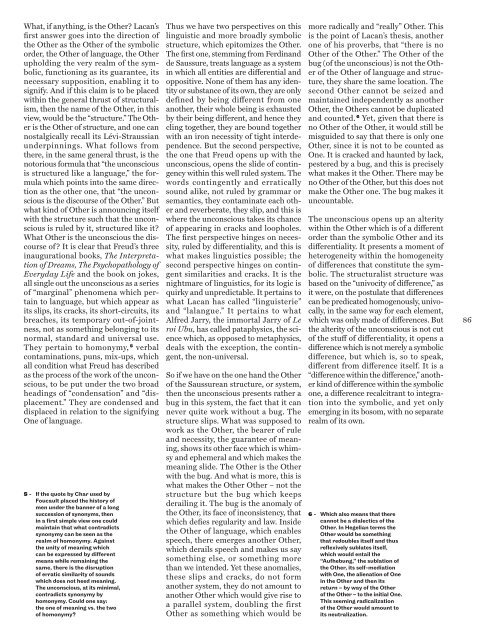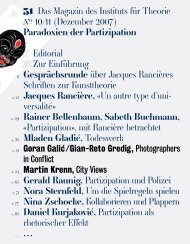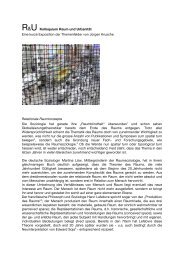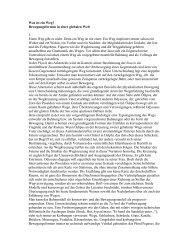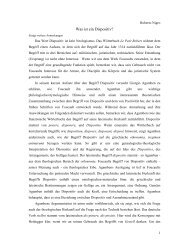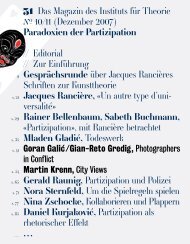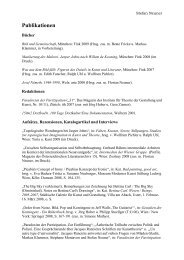Heft - Institut für Theorie ith
Heft - Institut für Theorie ith
Heft - Institut für Theorie ith
Sie wollen auch ein ePaper? Erhöhen Sie die Reichweite Ihrer Titel.
YUMPU macht aus Druck-PDFs automatisch weboptimierte ePaper, die Google liebt.
What, if anything, is the Other? Lacan’s<br />
first answer goes into the direction of<br />
the Other as the Other of the symbolic<br />
order, the Other of language, the Other<br />
upholding the very realm of the symbolic,<br />
functioning as its guarantee, its<br />
necessary supposition, enabling it to<br />
signify. And if this claim is to be placed<br />
w<strong>ith</strong>in the general thrust of structuralism,<br />
then the name of the Other, in this<br />
view, would be the “structure.” The Other<br />
is the Other of structure, and one can<br />
nostalgically recall its Lévi-Straussian<br />
underpinnings. What follows from<br />
there, in the same general thrust, is the<br />
notorious formula that “the unconscious<br />
is structured like a language,” the formula<br />
which points into the same direction<br />
as the other one, that “the unconscious<br />
is the discourse of the Other.” But<br />
what kind of Other is announcing itself<br />
w<strong>ith</strong> the structure such that the unconscious<br />
is ruled by it, structured like it?<br />
What Other is the unconscious the discourse<br />
of? It is clear that Freud’s three<br />
inaugurational books, The Interpretation<br />
of Dreams, The Psychopathology of<br />
Everyday Life and the book on jokes,<br />
all single out the unconscious as a series<br />
of “marginal” phenomena which pertain<br />
to language, but which appear as<br />
its slips, its cracks, its short-circuits, its<br />
breaches, its temporary out-of-jointness,<br />
not as something belonging to its<br />
normal, standard and universal use.<br />
They pertain to homonymy, 5 verbal<br />
contaminations, puns, mix-ups, which<br />
all condition what Freud has described<br />
as the process of the work of the unconscious,<br />
to be put under the two broad<br />
headings of “condensation” and “displacement.”<br />
They are condensed and<br />
displaced in relation to the signifying<br />
One of language.<br />
5 - If the quote by Char used by<br />
Foucault placed the history of<br />
men under the banner of a long<br />
succession of synonyms, then<br />
in a first simple view one could<br />
maintain that what contradicts<br />
synonymy can be seen as the<br />
realm of homonymy. Against<br />
the unity of meaning which<br />
can be expressed by different<br />
means while remaining the<br />
same, there is the disruption<br />
of erratic similarity of sounds<br />
which does not heed meaning.<br />
The unconscious, at its minimal,<br />
contradicts synonymy by<br />
homonymy. Could one say:<br />
the one of meaning vs. the two<br />
of homonymy?<br />
Thus we have two perspectives on this<br />
linguistic and more broadly symbolic<br />
structure, which epitomizes the Other.<br />
The first one, stemming from Ferdinand<br />
de Saussure, treats language as a system<br />
in which all entities are di≠erential and<br />
oppositive. None of them has any identity<br />
or substance of its own, they are only<br />
defined by being di≠erent from one<br />
another, their whole being is exhausted<br />
by their being di≠erent, and hence they<br />
cling together, they are bound together<br />
w<strong>ith</strong> an iron necessity of tight interdependence.<br />
But the second perspective,<br />
the one that Freud opens up w<strong>ith</strong> the<br />
unconscious, opens the slide of contingency<br />
w<strong>ith</strong>in this well ruled system. The<br />
words contingently and erratically<br />
sound alike, not ruled by grammar or<br />
semantics, they contaminate each other<br />
and reverberate, they slip, and this is<br />
where the unconscious takes its chance<br />
of appearing in cracks and loopholes.<br />
The first perspective hinges on necessity,<br />
ruled by di≠erentiality, and this is<br />
what makes linguistics possible; the<br />
second perspective hinges on contingent<br />
similarities and cracks. It is the<br />
nightmare of linguistics, for its logic is<br />
quirky and unpredictable. It pertains to<br />
what Lacan has called “linguisterie”<br />
and “lalangue.” It pertains to what<br />
Alfred Jarry, the immortal Jarry of Le<br />
roi Ubu, has called pataphysics, the science<br />
which, as opposed to metaphysics,<br />
deals w<strong>ith</strong> the exception, the contingent,<br />
the non-universal.<br />
So if we have on the one hand the Other<br />
of the Saussurean structure, or system,<br />
then the unconscious presents rather a<br />
bug in this system, the fact that it can<br />
never quite work w<strong>ith</strong>out a bug. The<br />
structure slips. What was supposed to<br />
work as the Other, the bearer of rule<br />
and necessity, the guarantee of meaning,<br />
shows its other face which is whimsy<br />
and ephemeral and which makes the<br />
meaning slide. The Other is the Other<br />
w<strong>ith</strong> the bug. And what is more, this is<br />
what makes the Other Other – not the<br />
structure but the bug which keeps<br />
derailing it. The bug is the anomaly of<br />
the Other, its face of inconsistency, that<br />
which defies regularity and law. Inside<br />
the Other of language, which enables<br />
speech, there emerges another Other,<br />
which derails speech and makes us say<br />
something else, or something more<br />
than we intended. Yet these anomalies,<br />
these slips and cracks, do not form<br />
another system, they do not amount to<br />
another Other which would give rise to<br />
a parallel system, doubling the first<br />
Other as something which would be<br />
more radically and “really” Other. This<br />
is the point of Lacan’s thesis, another<br />
one of his proverbs, that “there is no<br />
Other of the Other.” The Other of the<br />
bug (of the unconscious) is not the Other<br />
of the Other of language and structure,<br />
they share the same location. The<br />
second Other cannot be seized and<br />
maintained independently as another<br />
Other, the Others cannot be duplicated<br />
and counted. 6 Yet, given that there is<br />
no Other of the Other, it would still be<br />
misguided to say that there is only one<br />
Other, since it is not to be counted as<br />
One. It is cracked and haunted by lack,<br />
pestered by a bug, and this is precisely<br />
what makes it the Other. There may be<br />
no Other of the Other, but this does not<br />
make the Other one. The bug makes it<br />
uncountable.<br />
The unconscious opens up an alterity<br />
w<strong>ith</strong>in the Other which is of a di≠erent<br />
order than the symbolic Other and its<br />
di≠erentiality. It presents a moment of<br />
heterogeneity w<strong>ith</strong>in the homogeneity<br />
of di≠erences that constitute the symbolic.<br />
The structuralist structure was<br />
based on the “univocity of di≠erence,” as<br />
it were, on the postulate that di≠erences<br />
can be predicated homogenously, univocally,<br />
in the same way for each element,<br />
which was only made of di≠erences. But<br />
the alterity of the unconscious is not cut<br />
of the stu≠ of di≠erentiality, it opens a<br />
di≠erence which is not merely a symbolic<br />
di≠erence, but which is, so to speak,<br />
di≠erent from di≠erence itself. It is a<br />
“di≠erence w<strong>ith</strong>in the di≠erence,” another<br />
kind of di≠erence w<strong>ith</strong>in the symbolic<br />
one, a di≠erence recalcitrant to integration<br />
into the symbolic, and yet only<br />
emerging in its bosom, w<strong>ith</strong> no separate<br />
realm of its own.<br />
6 - Which also means that there<br />
cannot be a dialectics of the<br />
Other. In Hegelian terms the<br />
Other would be something<br />
that redoubles itself and thus<br />
reflexively sublates itself,<br />
which would entail the<br />
“Aufhebung,” the sublation of<br />
the Other, its self-mediation<br />
w<strong>ith</strong> One, the alienation of One<br />
in the Other and then its<br />
return – by way of the Other<br />
of the Other – to the initial One.<br />
This seeming radicalization<br />
of the Other would amount to<br />
its neutralization.<br />
86


